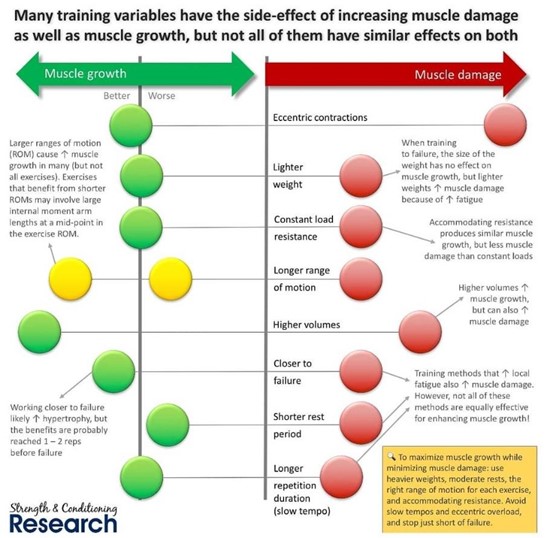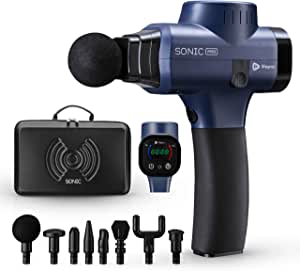
This is a clever graph from the British Strength & Conditioning Research Center. While I do not embrace a lot of the conclusions I like the layout and this graph reveals the complexity of doing enough but not too much.
Recovery, re-attaining hemostasis after a brutal hardcore lifting session, has been a topic of fevered discussion in the world of progressive resistance training since the 1960s. Why is recovery such a big deal in strength training? To optimize results obtained from a resistance training workout, i.e., to increase lean muscle mass (hypertrophy) and increase power and strength (simultaneously increasing athletic prowess) a 102% resistance training effort must be undertaken when the athlete is 100% rested. Anything less is less than optimal.
What does 100% rested mean? Utter and complete hemostasis: fresh, rested, totally healed from the aftereffects of the previous kick-ass resistance training session, called, “the rested effort.” Results will necessarily be submaximal if any athlete engages in a 102% effort when, say, 78% recovered. Whatever results obtained would have been inarguably better had the same workout been undertaken when 100% recovered. Normalcy, compete recovery, hemostasis, is elusive for a serious resistance trainer.
Those that have been in the iron game for decades, those that continually push the boundaries of their current capacities (where the gains are) continually wrestle with recovery. The iron elite have been on the forefront of recognizing the value of the rested effort. The iron elite have also been in the vanguard of exploring and discovery modes and methods for accelerating recovery.
There is the seemingly irresolvable and eternal recovery paradox: if a hardcore resistance trainer blasts his legs with limit squats and leg assistance work on Monday, crushes his chest and arms on Wednesday, then grinds through a brutal back workout, complete with back assistance work in the Friday training session – does that man ever train fully rested?
He would be if the body parts trained were not connected to a unifying body. Unfortunately for the arms they are also used in all types and kinds of flat benching and all types and kinds of overhead pressing. Leg and back training use many of the same muscles; heavy squatting and deadlifting each require erectors, abs, upper thighs, glutes, and hamstrings to contract maximally and repeatedly.
Conventional thinking holds that since you are only training each lift, each muscle and muscle group once a week, each muscle is given seven full days rest, more than enough time for that lift and the muscles involved in that lift to recover. This sounds wonderful – each muscle given seven full days to recover – but this is factually inaccurate.
Muscles need to be left alone, not called upon to help other muscle in other limit lifts. Knocking the bejeezus out of different body parts in three or four three hard and heavy lifting sessions each week makes sure that there is never a 100% rested effort. How could there be?
The best recovery method is based on fluidity. Know your body. Listen to it. One “rule of thumb” used by many of the iron elite: when you first feel fresh, rested, ready to train, wait another 24 hours. The extra day is a near guarantee of 100% hemostasis. Once truly recovered, blast a selected lift or body part into smithereens. Then feed and rest those stressed muscles.
Elite powerlifters have a long history of pushing the boundaries of minimalistic frequency. Many world champions have trained twice a week. Some have won world powerlifting championships (7 time world champion Dave Jacoby) training but once a week. What the masters of absolute strength (as opposed to explosive strength or sustained strength) discovered was that when a man is repetition squatting 700 + pounds and repetition bench pressing 400 + pounds, the recovery rules are different than for someone squatting and deadlifting 250 and rep benching 175.
For the elite powerlifter, the recovery challenge is this: if a man squats and deadlifts on the same day, the squat is always done first - and the deadlift always suffers. To be fair to the deadlift, the elite gave the deadlift its own day, training it 2-3 days later. Which was great for deadlift performance in a workout that doesn’t follow limit squatting. However now the upper thighs, abs, erectors, glutes and hamstrings are now being maximally taxed every 3-4 days. Only the super-fit recover in 3-4 days. The radical fringe came up with radical frequency modifications.
In the mid-1960s, Cassidy was a frequency radical, a heretical malcontent that advocated training a muscle twice a week. The settled science of the day was that unless a muscle was trained every 36 hours it would regress. Cassidy cut his training by a third, he went from thrice weekly to twice weekly and his progress skyrocketed. Others followed suit. Learn more about Hugh below.
In the 1980s, elite powerlifters like Ed Coan, Doug Furnas and Mark Chaillet cut training by 50% when they shifted from training muscles twice weekly (down from thrice) to training once weekly. On the front line of minimalism was world champion and world record holder mark Chaillet. Mark squatted and bench pressed on Monday and deadlifted on Thursday. He did no other exercises, period. Learn more about Mark below.
Ken introduced me to once-a-week training. Ken closed his gym to the public on Sunday. An elite group would gather and work their way through squats, bench presses, deadlifts, and arm training. I won the Connecticut state drug-free championships that year squatting 660, pulling 644 weighing 220. I now knew once-a-week training worked – mainly because it ensured the “rested effort.”
Recovery Accelerators
At some juncture, the iron elite step outside of box of conventional recovery thinking. In the quest for recovery, there are only so many tricks, tweaks, and adjustments to be made within the world of weight training. At some point, the weight trainer exhausts the possibilities and needs to step outside weight training to improve recovery from weight training. There are several tried and proven outside-the-box recovery accelerators.
Nutrition: Powerlifters discovered that by combining power training with eating tremendous amounts of food they grew gargantuan muscles. Calories accelerate the healing of muscle trauma and calories accelerate recovery. The magical muscle growth formula: blast the muscle in a hardcore, hypertrophy-inducing training session. Follow up with copious calories. Complete the growth cycle with deep sleep: train the muscle, feed the muscle, rest the muscle, grow the muscle. Do not train until fully healed and fully rested from the just-completed session. Learn about the basics of preparing tasty, nutrient-dense food in the post below.
Cardiovascular exercise: A trainee recovers quicker the fitter they are. Conversely, a trainee can be strong as an ox, able to bench press 500 pounds for reps, yet get winded walking up five flights of stairs. The unfit man takes longer to recover than a fit trainee. No one is suggesting be able to run a marathon, however some sort of weekly cardiovascular exercise improves internal organ function, aides digestion while accelerating the metabolism. Fit folks recover quicker than unfit folks.
Massage: The Soviet Union and East Germans introduced deep tissue massage as a restorative technique in the 1960s. Massage is used to this day and is seen as the recuperative highwater mark, perhaps the most effective of all post-workout recovery modes or methods. Of course, you need a skilled, highly paid masseuse to be standing by after every training session. Unless you are Usan Bolt or Lebron James, the fabulousness of deep tissue post-workout massage is beyond the financial means of normal people. The handheld massage models have made quantum leaps in terms of effectiveness and are now widely used. Some models also come with a heat feature. The Theragun is Stacy Gallagher's favorite. Check out options that we have tested by clicking the Amazon links below.
Hydrotherapy: Sauna, whirlpool, steam, swimming, ice baths, all have been shown to accelerate recovery when used intelligently, regularly, and with timely application. Some like it hot (steam/sauna/whirlpool) and some like it cold (ice cold shower, ice baths, cold water swims.) The warm hydro relaxes and soothes while the cold therapy reduces inflammation and accelerates the metabolism as the body must gear up fighting the cold. Post workout swimming flushes toxins and waste products while the cool pool water calms post-workout inflammation.
Deep sleep/power naps: The ability to fall into deep, restorative, regular sleep, is a gift that accelerates recovery. The body heals and repairs itself while deep in slumber. The length of the sleep session is not nearly as important as the quality of the sleep. Restless, busy-mind sleep is no sleep at all. When the body falls into unconsciousness, healing processes are unleashed. A further gift is the ability to take a well-timed “power nap.” Recharge and regenerate with power naps: they create short bursts of deep REM that revitalize and refresh.
Being fully recovered is the key to increasing strength and matching or exceeding training goals from the previous week. By using recovery accelerators "the rested effort" can be better utilized to make greater gains. At age 72 my training sessions may be shorter, but do not lack intensity. At this stage I am an expert at walking to the edge of my current physical limitations. Take a read of a recent post I wrote discussing the journey of staying in the training game.
Learn more about our philosophies check out our site Functional Strength. Join the community sign up below to our newsletter and receive our FREE Planning and Periodization Guide. Please feel free to send us a question here or leave a comment below.
Want the inside training scoop?
Join The Community
Our email content is full of value, void of hype, never pushy, and always free. As a BONUS you will receive our FREE planning & periodization template to help you with your training goals.












